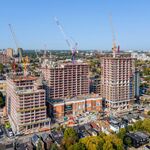unimaginative2
Senior Member
Spot the difference
Why does one park wear its emerald carpet throughout the summer, while another burns up, becoming a Triscuit in July?
PATRICIA CHISHOLM
Special to The Globe and Mail
August 11, 2007
It seems like a fairly basic equation. Take one city park, add grass seed, water generously. Result: soft islands of green amid the concrete, ideal for sports, hanging out or just plain resting the eyes. For many Torontonians trapped downtown during sweat-bath season, parks are a crucial sanctuary. Why then should one city-maintained park wear its emerald carpet throughout the summer, with only the occasional bald spot, while another burns up from end to end, becoming a dusty yellow mat the texture of straw by early July?
Such is the difference in the state of some parks in the downtown core, with the luxurious quality of the grass in Rosedale Park topping one end of the spectrum and the wretched patch of crabgrass and dirt at Campbell Park, near Lansdowne and Dupont, at the other. So poor is the surface at tiny Campbell Park that the pint-sized soccer players who gather there several times a week for summer house league games are enveloped in clouds of dust.
Kirstin Boutilier, whose son Caleb, 9, plays in a league that relies on the field, says the dry, hard surface gives her concern: "It's not maintained at all," she says. "It's dirt, and it's so bumpy, so uneven that you could pretty easily sustain a sports injury." What's especially disturbing, she says, is that the park is so heavily used.
Her soccer-playing son does not complain too much, but he does comment on the dust. "When he gets home and blows his nose, he shows me the dirt that comes out," she says. "It's pretty spectacular, when you think about what must be in their lungs. They're breathing pretty hard out there."
Sandy Straw, the manager of parks Toronto East York and parks bylaw enforcement, agrees that Campbell is not in good shape, but says the answer is simple: Rosedale, which was created in 1917 in a purchase from a lacrosse association, has had a built-in, underground sprinkler system since 1988. Watering, at least once a week, is controlled by automatic timers, avoiding the need for costly manpower. Campbell, created in 1964, lacks such a system.
In addition, according to Gord Andrews, manager of property management and maintenance services for the city, Rosedale benefits from high-quality loam soil, while Campbell makes do with low-quality builder's top soil, a legacy of the houses and church that occupied the site in the past.
Ms. Straw says she is unable to give a solid estimate of the cost of installing an underground sprinkler system. "It depends on the size," she says. "It could be anywhere from $5,000 [for a small garden] to $55,000" for a large park. Rosedale measures 2.95 hectares, while Campbell, which occupies part of one block on a residential street, is a mere .29 hectares. Why not water by hand? Especially such a small park. "We don't have the staff to do that, but in some of our parks, local volunteers have been doing that," she says.
Irrigation becomes particularly crucial during periods of low rainfall, as has been the case in Toronto this summer. "Generally speaking, we've had about half of our normal June, July and August rainfall," says David Phillips, a senior climatologist at Environment Canada. There have been 95 millimetres of rain in that time period so far, compared with a normal level of 170. (Over the past 24 years, only two other summers have been drier, 2005 and 1997.) It has also been warmer than normal, he notes; so that combination of dryness and heat can be disastrous for grassy areas with no artificial irrigation.
Ms. Straw acknowledges that the poor condition of the park is a concern and that there have been some recent discussions about entering into a partnership with non-city groups to have a sprinkler system installed, thereby avoiding the years-long wait that is likely involved if the city's capital budget is tapped. (Mr. Andrews notes that $135,000 has been allocated by the city for maintenance at Campbell in 2010, mostly for repairs to the park's aging splash pad.)
All this isn't much help to the budding soccer players, who can only expect the conditions at Campbell to deteriorate in the weeks ahead, with continued heavy use and, alas, no water. If it's anything like the conditions in Aurora, north of Toronto, where Mr. Phillips lives - and which has a watering ban in effect - walking across the grass will be "like walking on cornflakes," he says.
Why does one park wear its emerald carpet throughout the summer, while another burns up, becoming a Triscuit in July?
PATRICIA CHISHOLM
Special to The Globe and Mail
August 11, 2007
It seems like a fairly basic equation. Take one city park, add grass seed, water generously. Result: soft islands of green amid the concrete, ideal for sports, hanging out or just plain resting the eyes. For many Torontonians trapped downtown during sweat-bath season, parks are a crucial sanctuary. Why then should one city-maintained park wear its emerald carpet throughout the summer, with only the occasional bald spot, while another burns up from end to end, becoming a dusty yellow mat the texture of straw by early July?
Such is the difference in the state of some parks in the downtown core, with the luxurious quality of the grass in Rosedale Park topping one end of the spectrum and the wretched patch of crabgrass and dirt at Campbell Park, near Lansdowne and Dupont, at the other. So poor is the surface at tiny Campbell Park that the pint-sized soccer players who gather there several times a week for summer house league games are enveloped in clouds of dust.
Kirstin Boutilier, whose son Caleb, 9, plays in a league that relies on the field, says the dry, hard surface gives her concern: "It's not maintained at all," she says. "It's dirt, and it's so bumpy, so uneven that you could pretty easily sustain a sports injury." What's especially disturbing, she says, is that the park is so heavily used.
Her soccer-playing son does not complain too much, but he does comment on the dust. "When he gets home and blows his nose, he shows me the dirt that comes out," she says. "It's pretty spectacular, when you think about what must be in their lungs. They're breathing pretty hard out there."
Sandy Straw, the manager of parks Toronto East York and parks bylaw enforcement, agrees that Campbell is not in good shape, but says the answer is simple: Rosedale, which was created in 1917 in a purchase from a lacrosse association, has had a built-in, underground sprinkler system since 1988. Watering, at least once a week, is controlled by automatic timers, avoiding the need for costly manpower. Campbell, created in 1964, lacks such a system.
In addition, according to Gord Andrews, manager of property management and maintenance services for the city, Rosedale benefits from high-quality loam soil, while Campbell makes do with low-quality builder's top soil, a legacy of the houses and church that occupied the site in the past.
Ms. Straw says she is unable to give a solid estimate of the cost of installing an underground sprinkler system. "It depends on the size," she says. "It could be anywhere from $5,000 [for a small garden] to $55,000" for a large park. Rosedale measures 2.95 hectares, while Campbell, which occupies part of one block on a residential street, is a mere .29 hectares. Why not water by hand? Especially such a small park. "We don't have the staff to do that, but in some of our parks, local volunteers have been doing that," she says.
Irrigation becomes particularly crucial during periods of low rainfall, as has been the case in Toronto this summer. "Generally speaking, we've had about half of our normal June, July and August rainfall," says David Phillips, a senior climatologist at Environment Canada. There have been 95 millimetres of rain in that time period so far, compared with a normal level of 170. (Over the past 24 years, only two other summers have been drier, 2005 and 1997.) It has also been warmer than normal, he notes; so that combination of dryness and heat can be disastrous for grassy areas with no artificial irrigation.
Ms. Straw acknowledges that the poor condition of the park is a concern and that there have been some recent discussions about entering into a partnership with non-city groups to have a sprinkler system installed, thereby avoiding the years-long wait that is likely involved if the city's capital budget is tapped. (Mr. Andrews notes that $135,000 has been allocated by the city for maintenance at Campbell in 2010, mostly for repairs to the park's aging splash pad.)
All this isn't much help to the budding soccer players, who can only expect the conditions at Campbell to deteriorate in the weeks ahead, with continued heavy use and, alas, no water. If it's anything like the conditions in Aurora, north of Toronto, where Mr. Phillips lives - and which has a watering ban in effect - walking across the grass will be "like walking on cornflakes," he says.




